Strategic Change Management Analysis for 3Sixty GSM Company
VerifiedAdded on 2020/02/19
|50
|13722
|37
Report
AI Summary
This report provides a comprehensive analysis of strategic change management within 3Sixty GSM, an IT and service provider operating in Dubai and Saudi Arabia. It begins with an executive summary outlining the importance of strategic change for business improvement, competitive advantage, and meeting target audience expectations. The report then dives into the company background and the need for change, followed by an examination of various change management models, including Kurt Lewin's Change Model and the McKinsey 7S Model, with a focus on their relevance to 3Sixty GSM. The study assesses the value of strategic intervention techniques and the factors driving the need for change, as well as the resource implications of not responding to change. Furthermore, the report explores systems for stakeholder involvement, change management strategies, and methods for managing resistance to change. It concludes with recommendations and a strategic plan for implementing the change process, along with measures to monitor progress. The report emphasizes the importance of strategic change in enhancing competitive advantage and adapting to market challenges.
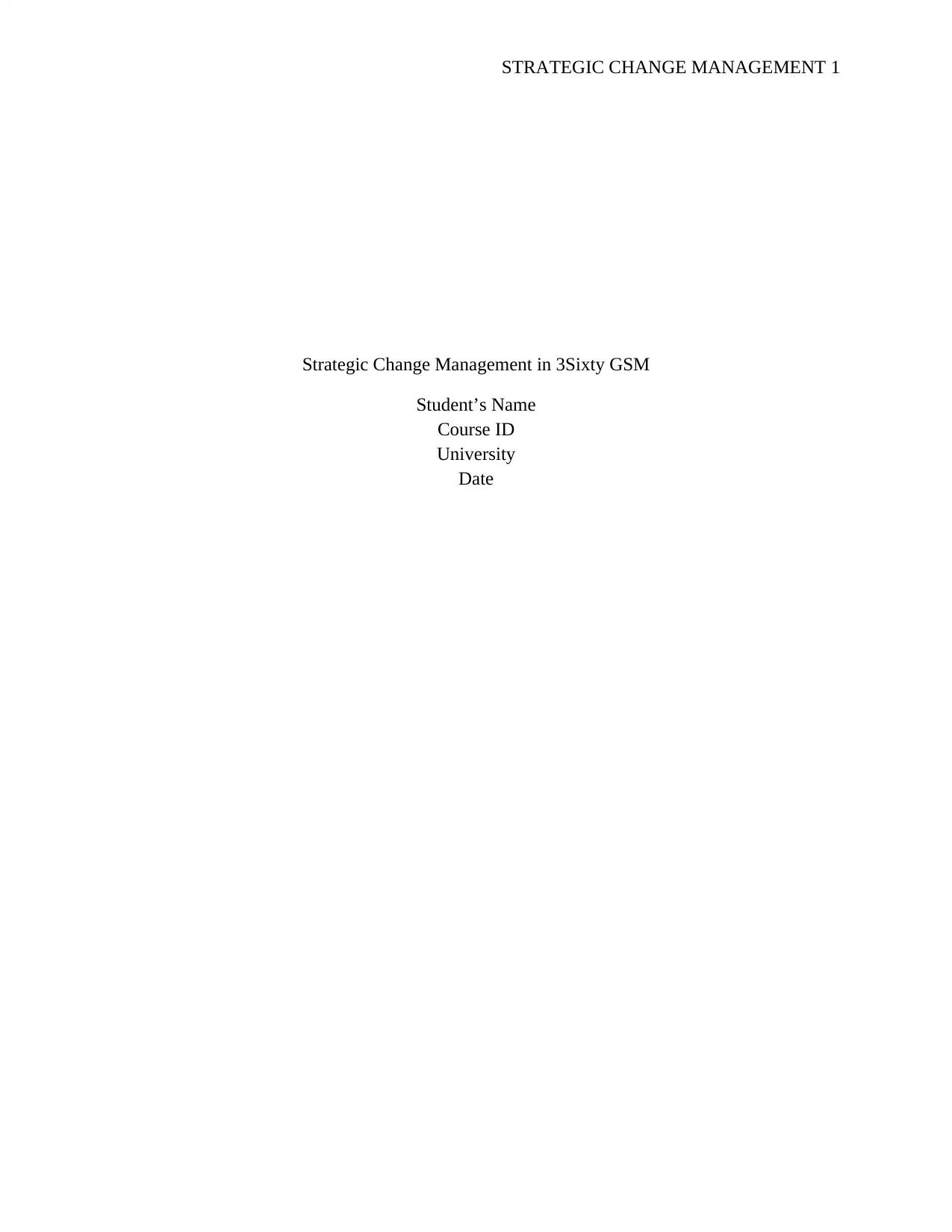
STRATEGIC CHANGE MANAGEMENT 1
Strategic Change Management in 3Sixty GSM
Student’s Name
Course ID
University
Date
Strategic Change Management in 3Sixty GSM
Student’s Name
Course ID
University
Date
Paraphrase This Document
Need a fresh take? Get an instant paraphrase of this document with our AI Paraphraser
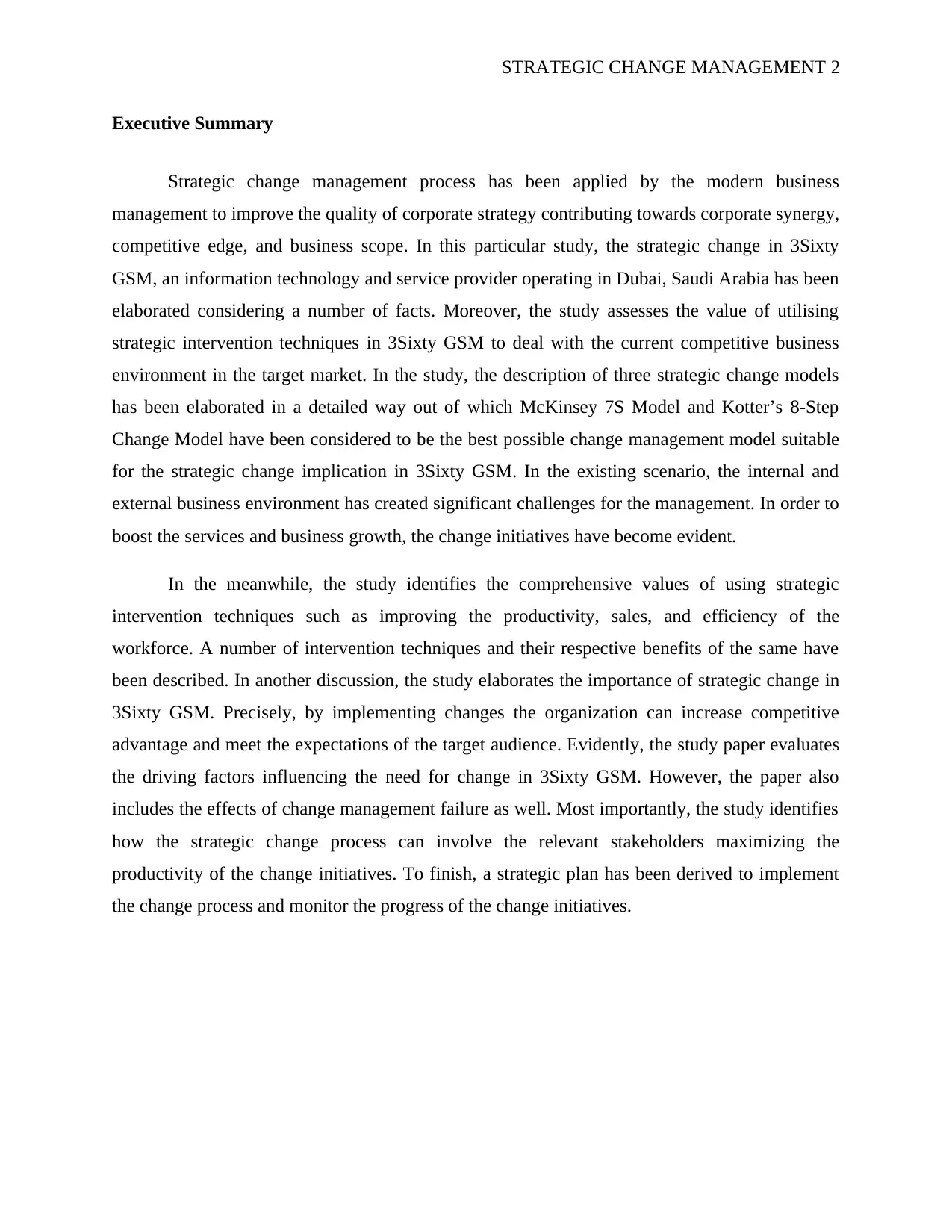
STRATEGIC CHANGE MANAGEMENT 2
Executive Summary
Strategic change management process has been applied by the modern business
management to improve the quality of corporate strategy contributing towards corporate synergy,
competitive edge, and business scope. In this particular study, the strategic change in 3Sixty
GSM, an information technology and service provider operating in Dubai, Saudi Arabia has been
elaborated considering a number of facts. Moreover, the study assesses the value of utilising
strategic intervention techniques in 3Sixty GSM to deal with the current competitive business
environment in the target market. In the study, the description of three strategic change models
has been elaborated in a detailed way out of which McKinsey 7S Model and Kotter’s 8-Step
Change Model have been considered to be the best possible change management model suitable
for the strategic change implication in 3Sixty GSM. In the existing scenario, the internal and
external business environment has created significant challenges for the management. In order to
boost the services and business growth, the change initiatives have become evident.
In the meanwhile, the study identifies the comprehensive values of using strategic
intervention techniques such as improving the productivity, sales, and efficiency of the
workforce. A number of intervention techniques and their respective benefits of the same have
been described. In another discussion, the study elaborates the importance of strategic change in
3Sixty GSM. Precisely, by implementing changes the organization can increase competitive
advantage and meet the expectations of the target audience. Evidently, the study paper evaluates
the driving factors influencing the need for change in 3Sixty GSM. However, the paper also
includes the effects of change management failure as well. Most importantly, the study identifies
how the strategic change process can involve the relevant stakeholders maximizing the
productivity of the change initiatives. To finish, a strategic plan has been derived to implement
the change process and monitor the progress of the change initiatives.
Executive Summary
Strategic change management process has been applied by the modern business
management to improve the quality of corporate strategy contributing towards corporate synergy,
competitive edge, and business scope. In this particular study, the strategic change in 3Sixty
GSM, an information technology and service provider operating in Dubai, Saudi Arabia has been
elaborated considering a number of facts. Moreover, the study assesses the value of utilising
strategic intervention techniques in 3Sixty GSM to deal with the current competitive business
environment in the target market. In the study, the description of three strategic change models
has been elaborated in a detailed way out of which McKinsey 7S Model and Kotter’s 8-Step
Change Model have been considered to be the best possible change management model suitable
for the strategic change implication in 3Sixty GSM. In the existing scenario, the internal and
external business environment has created significant challenges for the management. In order to
boost the services and business growth, the change initiatives have become evident.
In the meanwhile, the study identifies the comprehensive values of using strategic
intervention techniques such as improving the productivity, sales, and efficiency of the
workforce. A number of intervention techniques and their respective benefits of the same have
been described. In another discussion, the study elaborates the importance of strategic change in
3Sixty GSM. Precisely, by implementing changes the organization can increase competitive
advantage and meet the expectations of the target audience. Evidently, the study paper evaluates
the driving factors influencing the need for change in 3Sixty GSM. However, the paper also
includes the effects of change management failure as well. Most importantly, the study identifies
how the strategic change process can involve the relevant stakeholders maximizing the
productivity of the change initiatives. To finish, a strategic plan has been derived to implement
the change process and monitor the progress of the change initiatives.
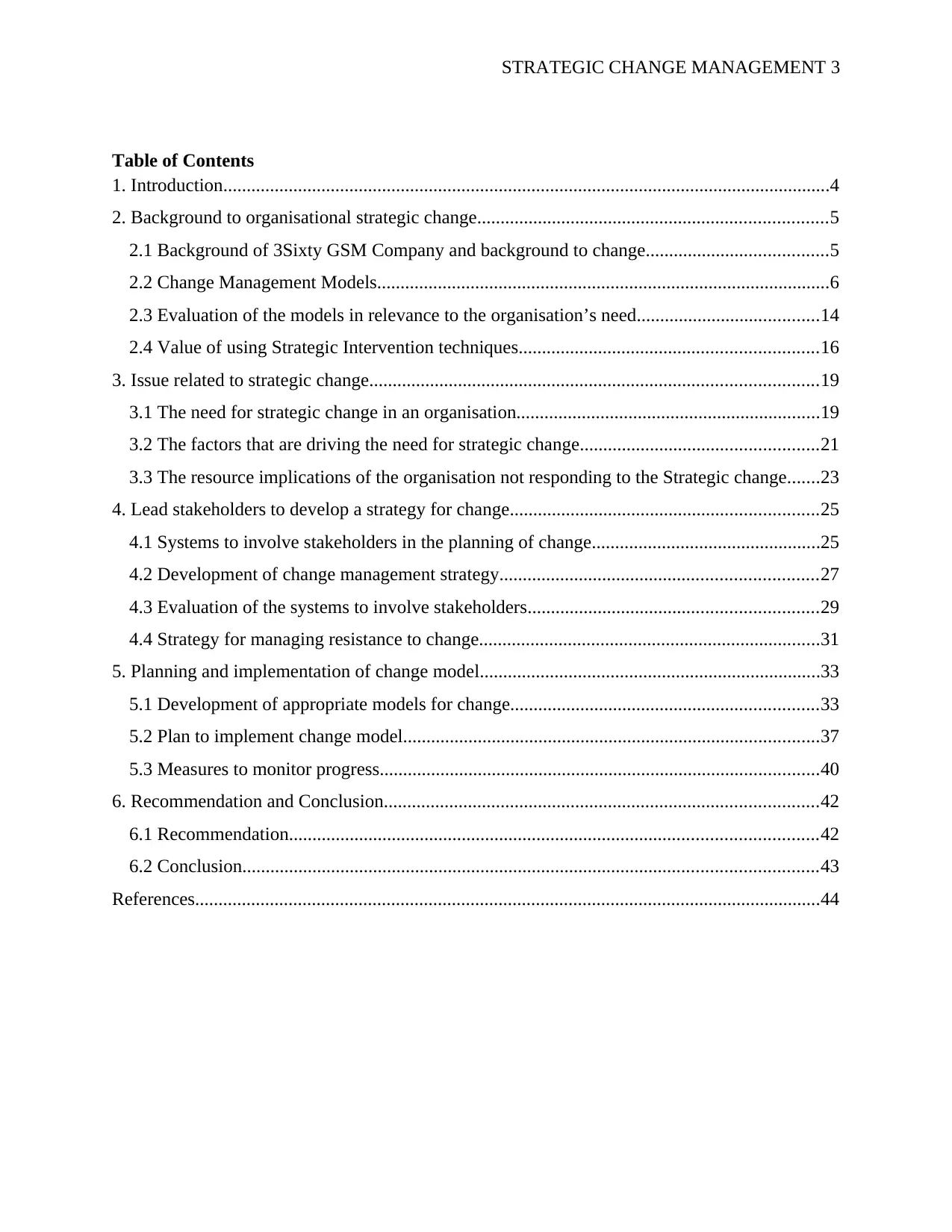
STRATEGIC CHANGE MANAGEMENT 3
Table of Contents
1. Introduction..................................................................................................................................4
2. Background to organisational strategic change...........................................................................5
2.1 Background of 3Sixty GSM Company and background to change.......................................5
2.2 Change Management Models.................................................................................................6
2.3 Evaluation of the models in relevance to the organisation’s need.......................................14
2.4 Value of using Strategic Intervention techniques................................................................16
3. Issue related to strategic change................................................................................................19
3.1 The need for strategic change in an organisation.................................................................19
3.2 The factors that are driving the need for strategic change...................................................21
3.3 The resource implications of the organisation not responding to the Strategic change.......23
4. Lead stakeholders to develop a strategy for change..................................................................25
4.1 Systems to involve stakeholders in the planning of change.................................................25
4.2 Development of change management strategy....................................................................27
4.3 Evaluation of the systems to involve stakeholders..............................................................29
4.4 Strategy for managing resistance to change.........................................................................31
5. Planning and implementation of change model.........................................................................33
5.1 Development of appropriate models for change..................................................................33
5.2 Plan to implement change model.........................................................................................37
5.3 Measures to monitor progress..............................................................................................40
6. Recommendation and Conclusion.............................................................................................42
6.1 Recommendation.................................................................................................................42
6.2 Conclusion...........................................................................................................................43
References......................................................................................................................................44
Table of Contents
1. Introduction..................................................................................................................................4
2. Background to organisational strategic change...........................................................................5
2.1 Background of 3Sixty GSM Company and background to change.......................................5
2.2 Change Management Models.................................................................................................6
2.3 Evaluation of the models in relevance to the organisation’s need.......................................14
2.4 Value of using Strategic Intervention techniques................................................................16
3. Issue related to strategic change................................................................................................19
3.1 The need for strategic change in an organisation.................................................................19
3.2 The factors that are driving the need for strategic change...................................................21
3.3 The resource implications of the organisation not responding to the Strategic change.......23
4. Lead stakeholders to develop a strategy for change..................................................................25
4.1 Systems to involve stakeholders in the planning of change.................................................25
4.2 Development of change management strategy....................................................................27
4.3 Evaluation of the systems to involve stakeholders..............................................................29
4.4 Strategy for managing resistance to change.........................................................................31
5. Planning and implementation of change model.........................................................................33
5.1 Development of appropriate models for change..................................................................33
5.2 Plan to implement change model.........................................................................................37
5.3 Measures to monitor progress..............................................................................................40
6. Recommendation and Conclusion.............................................................................................42
6.1 Recommendation.................................................................................................................42
6.2 Conclusion...........................................................................................................................43
References......................................................................................................................................44
⊘ This is a preview!⊘
Do you want full access?
Subscribe today to unlock all pages.

Trusted by 1+ million students worldwide
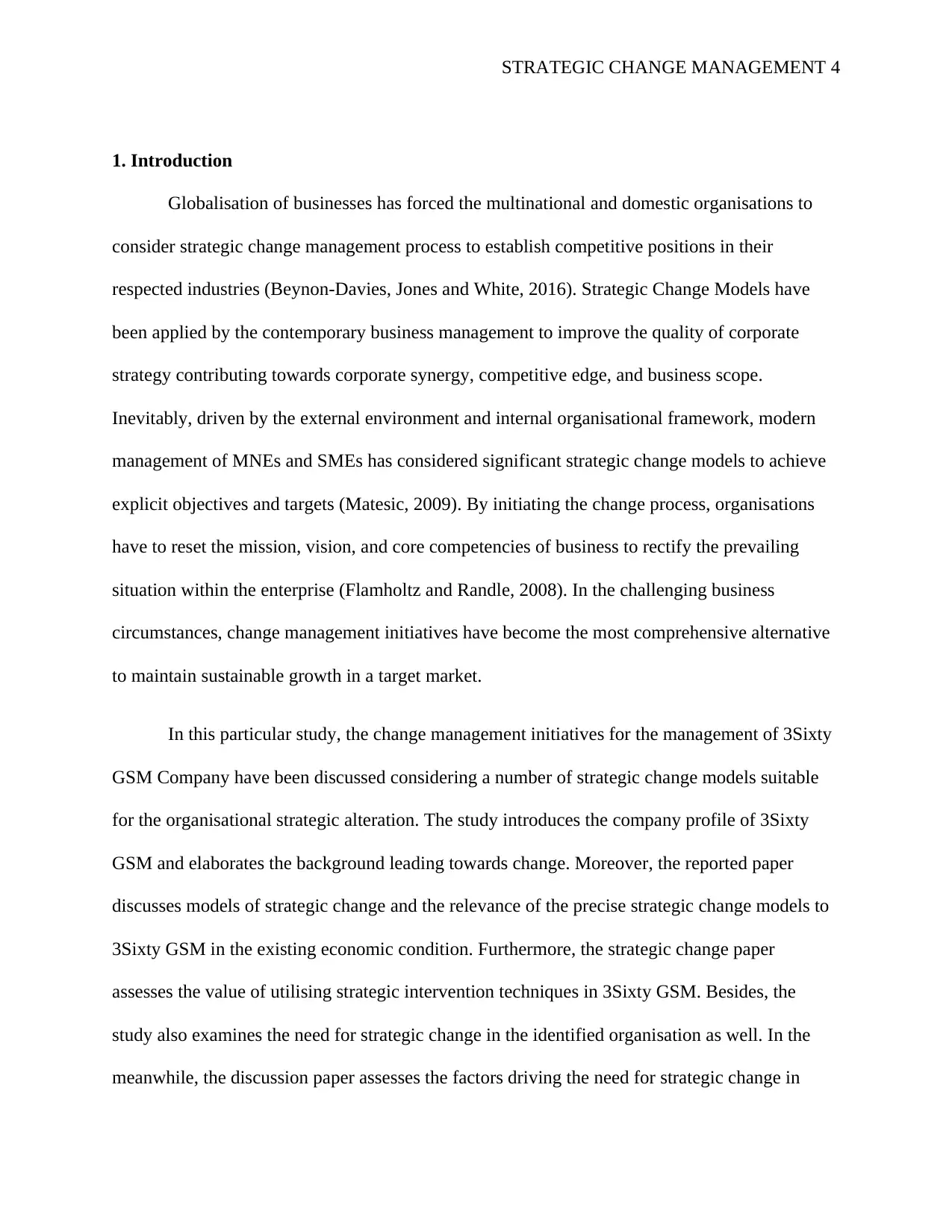
STRATEGIC CHANGE MANAGEMENT 4
1. Introduction
Globalisation of businesses has forced the multinational and domestic organisations to
consider strategic change management process to establish competitive positions in their
respected industries (Beynon-Davies, Jones and White, 2016). Strategic Change Models have
been applied by the contemporary business management to improve the quality of corporate
strategy contributing towards corporate synergy, competitive edge, and business scope.
Inevitably, driven by the external environment and internal organisational framework, modern
management of MNEs and SMEs has considered significant strategic change models to achieve
explicit objectives and targets (Matesic, 2009). By initiating the change process, organisations
have to reset the mission, vision, and core competencies of business to rectify the prevailing
situation within the enterprise (Flamholtz and Randle, 2008). In the challenging business
circumstances, change management initiatives have become the most comprehensive alternative
to maintain sustainable growth in a target market.
In this particular study, the change management initiatives for the management of 3Sixty
GSM Company have been discussed considering a number of strategic change models suitable
for the organisational strategic alteration. The study introduces the company profile of 3Sixty
GSM and elaborates the background leading towards change. Moreover, the reported paper
discusses models of strategic change and the relevance of the precise strategic change models to
3Sixty GSM in the existing economic condition. Furthermore, the strategic change paper
assesses the value of utilising strategic intervention techniques in 3Sixty GSM. Besides, the
study also examines the need for strategic change in the identified organisation as well. In the
meanwhile, the discussion paper assesses the factors driving the need for strategic change in
1. Introduction
Globalisation of businesses has forced the multinational and domestic organisations to
consider strategic change management process to establish competitive positions in their
respected industries (Beynon-Davies, Jones and White, 2016). Strategic Change Models have
been applied by the contemporary business management to improve the quality of corporate
strategy contributing towards corporate synergy, competitive edge, and business scope.
Inevitably, driven by the external environment and internal organisational framework, modern
management of MNEs and SMEs has considered significant strategic change models to achieve
explicit objectives and targets (Matesic, 2009). By initiating the change process, organisations
have to reset the mission, vision, and core competencies of business to rectify the prevailing
situation within the enterprise (Flamholtz and Randle, 2008). In the challenging business
circumstances, change management initiatives have become the most comprehensive alternative
to maintain sustainable growth in a target market.
In this particular study, the change management initiatives for the management of 3Sixty
GSM Company have been discussed considering a number of strategic change models suitable
for the organisational strategic alteration. The study introduces the company profile of 3Sixty
GSM and elaborates the background leading towards change. Moreover, the reported paper
discusses models of strategic change and the relevance of the precise strategic change models to
3Sixty GSM in the existing economic condition. Furthermore, the strategic change paper
assesses the value of utilising strategic intervention techniques in 3Sixty GSM. Besides, the
study also examines the need for strategic change in the identified organisation as well. In the
meanwhile, the discussion paper assesses the factors driving the need for strategic change in
Paraphrase This Document
Need a fresh take? Get an instant paraphrase of this document with our AI Paraphraser
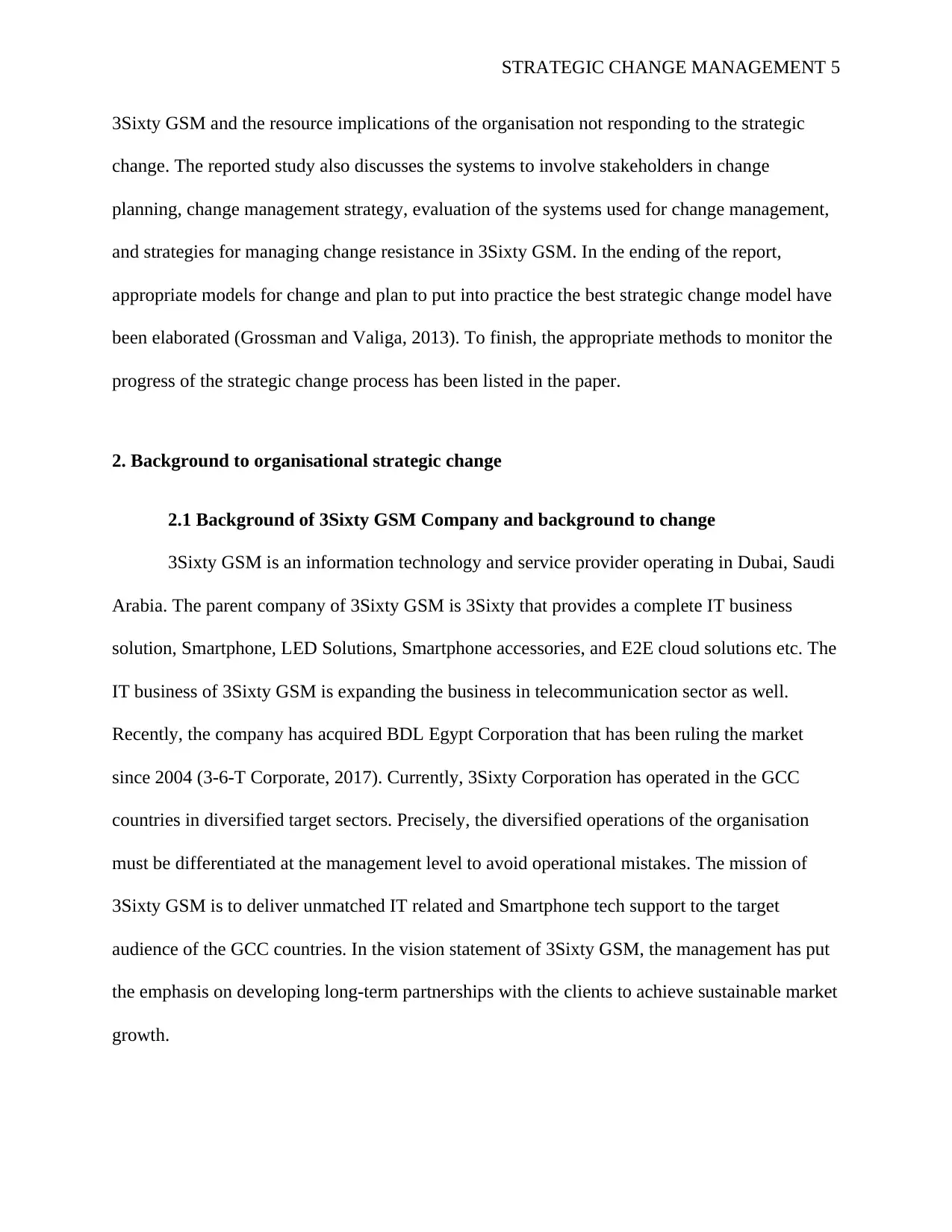
STRATEGIC CHANGE MANAGEMENT 5
3Sixty GSM and the resource implications of the organisation not responding to the strategic
change. The reported study also discusses the systems to involve stakeholders in change
planning, change management strategy, evaluation of the systems used for change management,
and strategies for managing change resistance in 3Sixty GSM. In the ending of the report,
appropriate models for change and plan to put into practice the best strategic change model have
been elaborated (Grossman and Valiga, 2013). To finish, the appropriate methods to monitor the
progress of the strategic change process has been listed in the paper.
2. Background to organisational strategic change
2.1 Background of 3Sixty GSM Company and background to change
3Sixty GSM is an information technology and service provider operating in Dubai, Saudi
Arabia. The parent company of 3Sixty GSM is 3Sixty that provides a complete IT business
solution, Smartphone, LED Solutions, Smartphone accessories, and E2E cloud solutions etc. The
IT business of 3Sixty GSM is expanding the business in telecommunication sector as well.
Recently, the company has acquired BDL Egypt Corporation that has been ruling the market
since 2004 (3-6-T Corporate, 2017). Currently, 3Sixty Corporation has operated in the GCC
countries in diversified target sectors. Precisely, the diversified operations of the organisation
must be differentiated at the management level to avoid operational mistakes. The mission of
3Sixty GSM is to deliver unmatched IT related and Smartphone tech support to the target
audience of the GCC countries. In the vision statement of 3Sixty GSM, the management has put
the emphasis on developing long-term partnerships with the clients to achieve sustainable market
growth.
3Sixty GSM and the resource implications of the organisation not responding to the strategic
change. The reported study also discusses the systems to involve stakeholders in change
planning, change management strategy, evaluation of the systems used for change management,
and strategies for managing change resistance in 3Sixty GSM. In the ending of the report,
appropriate models for change and plan to put into practice the best strategic change model have
been elaborated (Grossman and Valiga, 2013). To finish, the appropriate methods to monitor the
progress of the strategic change process has been listed in the paper.
2. Background to organisational strategic change
2.1 Background of 3Sixty GSM Company and background to change
3Sixty GSM is an information technology and service provider operating in Dubai, Saudi
Arabia. The parent company of 3Sixty GSM is 3Sixty that provides a complete IT business
solution, Smartphone, LED Solutions, Smartphone accessories, and E2E cloud solutions etc. The
IT business of 3Sixty GSM is expanding the business in telecommunication sector as well.
Recently, the company has acquired BDL Egypt Corporation that has been ruling the market
since 2004 (3-6-T Corporate, 2017). Currently, 3Sixty Corporation has operated in the GCC
countries in diversified target sectors. Precisely, the diversified operations of the organisation
must be differentiated at the management level to avoid operational mistakes. The mission of
3Sixty GSM is to deliver unmatched IT related and Smartphone tech support to the target
audience of the GCC countries. In the vision statement of 3Sixty GSM, the management has put
the emphasis on developing long-term partnerships with the clients to achieve sustainable market
growth.
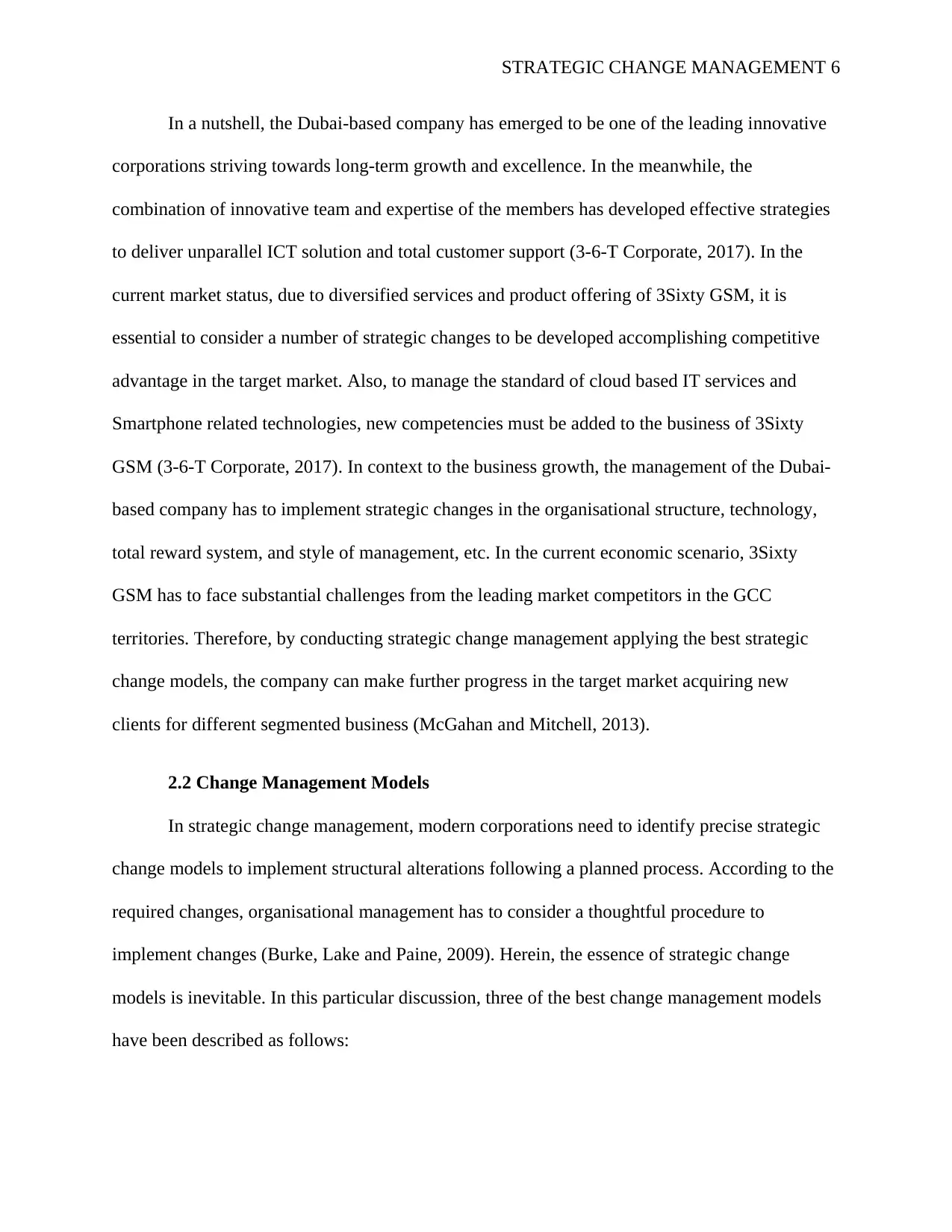
STRATEGIC CHANGE MANAGEMENT 6
In a nutshell, the Dubai-based company has emerged to be one of the leading innovative
corporations striving towards long-term growth and excellence. In the meanwhile, the
combination of innovative team and expertise of the members has developed effective strategies
to deliver unparallel ICT solution and total customer support (3-6-T Corporate, 2017). In the
current market status, due to diversified services and product offering of 3Sixty GSM, it is
essential to consider a number of strategic changes to be developed accomplishing competitive
advantage in the target market. Also, to manage the standard of cloud based IT services and
Smartphone related technologies, new competencies must be added to the business of 3Sixty
GSM (3-6-T Corporate, 2017). In context to the business growth, the management of the Dubai-
based company has to implement strategic changes in the organisational structure, technology,
total reward system, and style of management, etc. In the current economic scenario, 3Sixty
GSM has to face substantial challenges from the leading market competitors in the GCC
territories. Therefore, by conducting strategic change management applying the best strategic
change models, the company can make further progress in the target market acquiring new
clients for different segmented business (McGahan and Mitchell, 2013).
2.2 Change Management Models
In strategic change management, modern corporations need to identify precise strategic
change models to implement structural alterations following a planned process. According to the
required changes, organisational management has to consider a thoughtful procedure to
implement changes (Burke, Lake and Paine, 2009). Herein, the essence of strategic change
models is inevitable. In this particular discussion, three of the best change management models
have been described as follows:
In a nutshell, the Dubai-based company has emerged to be one of the leading innovative
corporations striving towards long-term growth and excellence. In the meanwhile, the
combination of innovative team and expertise of the members has developed effective strategies
to deliver unparallel ICT solution and total customer support (3-6-T Corporate, 2017). In the
current market status, due to diversified services and product offering of 3Sixty GSM, it is
essential to consider a number of strategic changes to be developed accomplishing competitive
advantage in the target market. Also, to manage the standard of cloud based IT services and
Smartphone related technologies, new competencies must be added to the business of 3Sixty
GSM (3-6-T Corporate, 2017). In context to the business growth, the management of the Dubai-
based company has to implement strategic changes in the organisational structure, technology,
total reward system, and style of management, etc. In the current economic scenario, 3Sixty
GSM has to face substantial challenges from the leading market competitors in the GCC
territories. Therefore, by conducting strategic change management applying the best strategic
change models, the company can make further progress in the target market acquiring new
clients for different segmented business (McGahan and Mitchell, 2013).
2.2 Change Management Models
In strategic change management, modern corporations need to identify precise strategic
change models to implement structural alterations following a planned process. According to the
required changes, organisational management has to consider a thoughtful procedure to
implement changes (Burke, Lake and Paine, 2009). Herein, the essence of strategic change
models is inevitable. In this particular discussion, three of the best change management models
have been described as follows:
⊘ This is a preview!⊘
Do you want full access?
Subscribe today to unlock all pages.

Trusted by 1+ million students worldwide
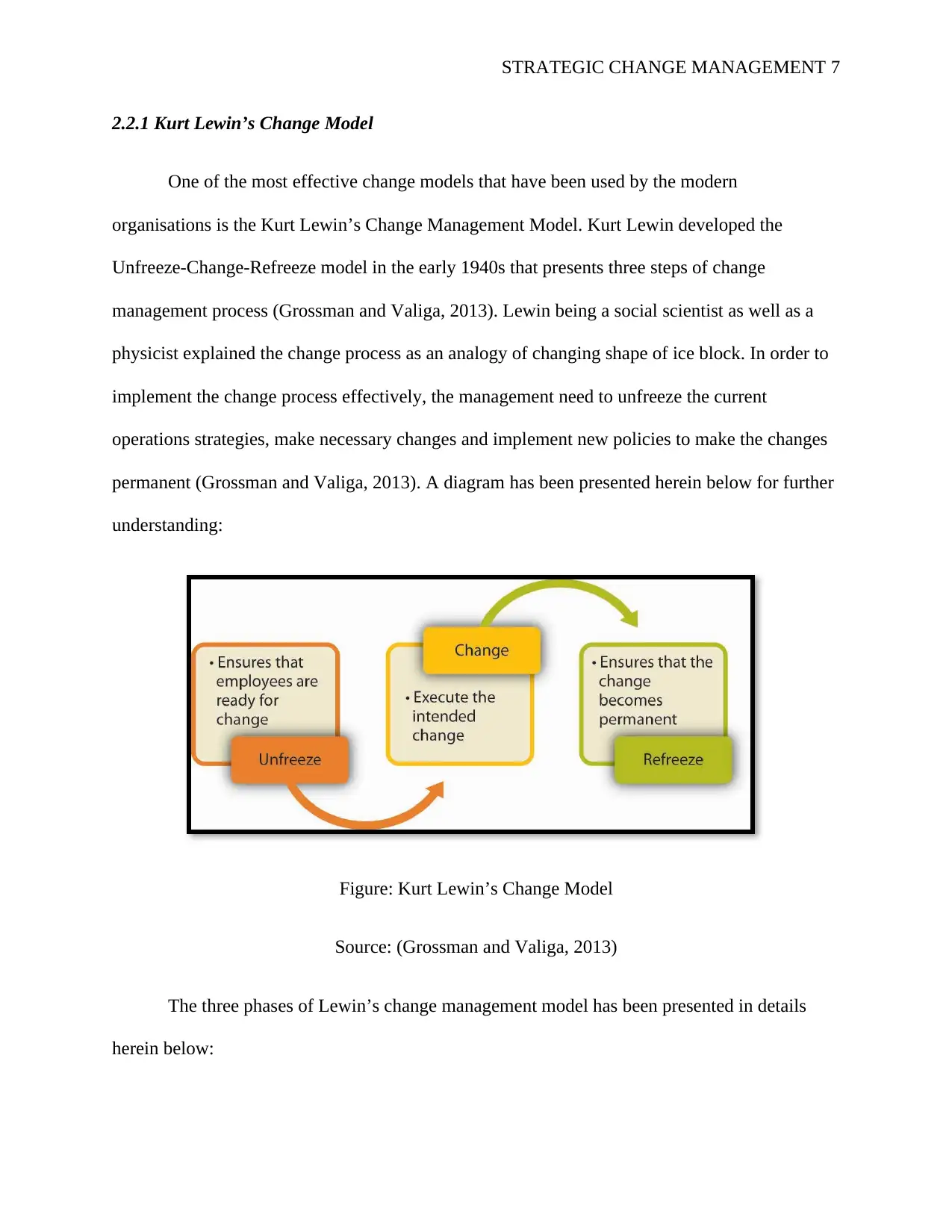
STRATEGIC CHANGE MANAGEMENT 7
2.2.1 Kurt Lewin’s Change Model
One of the most effective change models that have been used by the modern
organisations is the Kurt Lewin’s Change Management Model. Kurt Lewin developed the
Unfreeze-Change-Refreeze model in the early 1940s that presents three steps of change
management process (Grossman and Valiga, 2013). Lewin being a social scientist as well as a
physicist explained the change process as an analogy of changing shape of ice block. In order to
implement the change process effectively, the management need to unfreeze the current
operations strategies, make necessary changes and implement new policies to make the changes
permanent (Grossman and Valiga, 2013). A diagram has been presented herein below for further
understanding:
Figure: Kurt Lewin’s Change Model
Source: (Grossman and Valiga, 2013)
The three phases of Lewin’s change management model has been presented in details
herein below:
2.2.1 Kurt Lewin’s Change Model
One of the most effective change models that have been used by the modern
organisations is the Kurt Lewin’s Change Management Model. Kurt Lewin developed the
Unfreeze-Change-Refreeze model in the early 1940s that presents three steps of change
management process (Grossman and Valiga, 2013). Lewin being a social scientist as well as a
physicist explained the change process as an analogy of changing shape of ice block. In order to
implement the change process effectively, the management need to unfreeze the current
operations strategies, make necessary changes and implement new policies to make the changes
permanent (Grossman and Valiga, 2013). A diagram has been presented herein below for further
understanding:
Figure: Kurt Lewin’s Change Model
Source: (Grossman and Valiga, 2013)
The three phases of Lewin’s change management model has been presented in details
herein below:
Paraphrase This Document
Need a fresh take? Get an instant paraphrase of this document with our AI Paraphraser
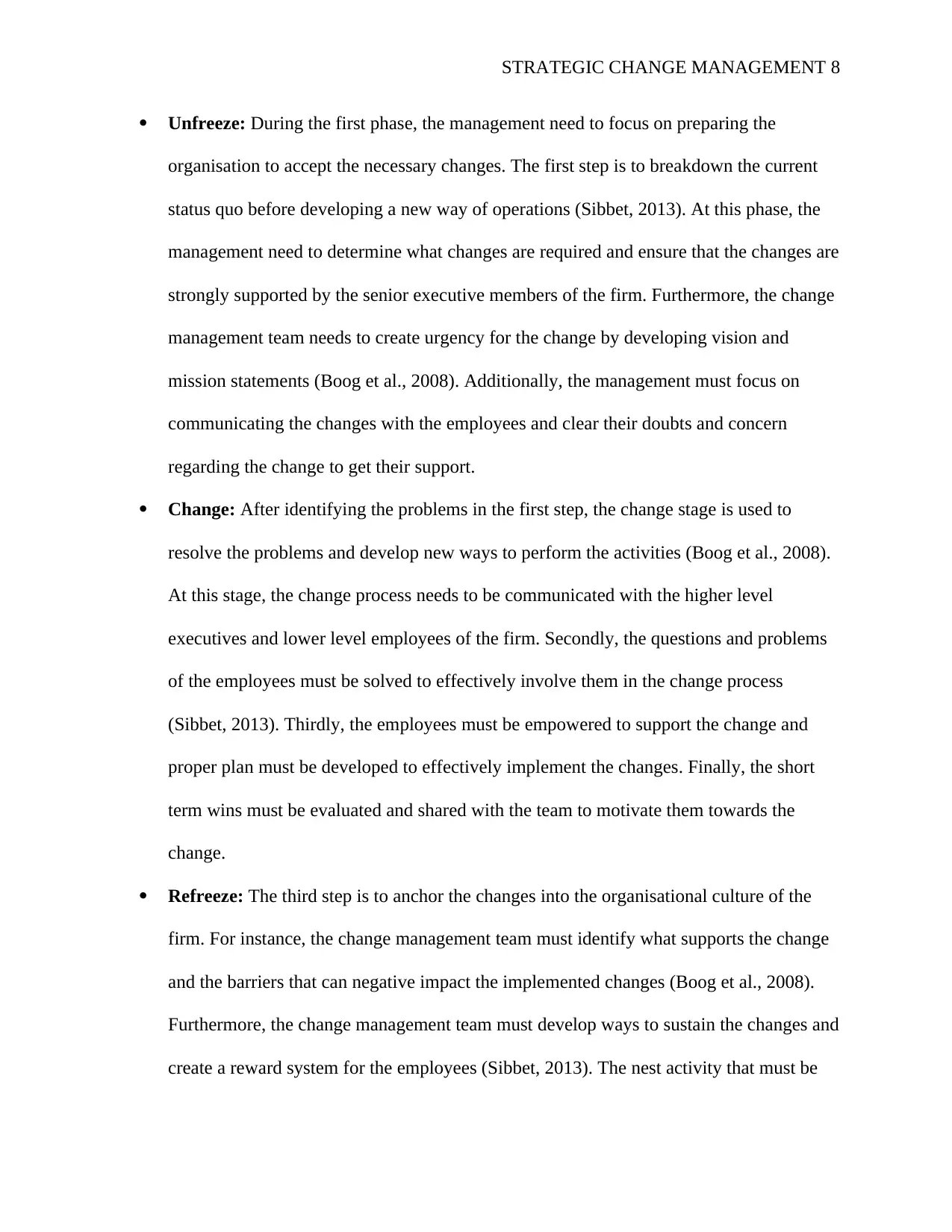
STRATEGIC CHANGE MANAGEMENT 8
Unfreeze: During the first phase, the management need to focus on preparing the
organisation to accept the necessary changes. The first step is to breakdown the current
status quo before developing a new way of operations (Sibbet, 2013). At this phase, the
management need to determine what changes are required and ensure that the changes are
strongly supported by the senior executive members of the firm. Furthermore, the change
management team needs to create urgency for the change by developing vision and
mission statements (Boog et al., 2008). Additionally, the management must focus on
communicating the changes with the employees and clear their doubts and concern
regarding the change to get their support.
Change: After identifying the problems in the first step, the change stage is used to
resolve the problems and develop new ways to perform the activities (Boog et al., 2008).
At this stage, the change process needs to be communicated with the higher level
executives and lower level employees of the firm. Secondly, the questions and problems
of the employees must be solved to effectively involve them in the change process
(Sibbet, 2013). Thirdly, the employees must be empowered to support the change and
proper plan must be developed to effectively implement the changes. Finally, the short
term wins must be evaluated and shared with the team to motivate them towards the
change.
Refreeze: The third step is to anchor the changes into the organisational culture of the
firm. For instance, the change management team must identify what supports the change
and the barriers that can negative impact the implemented changes (Boog et al., 2008).
Furthermore, the change management team must develop ways to sustain the changes and
create a reward system for the employees (Sibbet, 2013). The nest activity that must be
Unfreeze: During the first phase, the management need to focus on preparing the
organisation to accept the necessary changes. The first step is to breakdown the current
status quo before developing a new way of operations (Sibbet, 2013). At this phase, the
management need to determine what changes are required and ensure that the changes are
strongly supported by the senior executive members of the firm. Furthermore, the change
management team needs to create urgency for the change by developing vision and
mission statements (Boog et al., 2008). Additionally, the management must focus on
communicating the changes with the employees and clear their doubts and concern
regarding the change to get their support.
Change: After identifying the problems in the first step, the change stage is used to
resolve the problems and develop new ways to perform the activities (Boog et al., 2008).
At this stage, the change process needs to be communicated with the higher level
executives and lower level employees of the firm. Secondly, the questions and problems
of the employees must be solved to effectively involve them in the change process
(Sibbet, 2013). Thirdly, the employees must be empowered to support the change and
proper plan must be developed to effectively implement the changes. Finally, the short
term wins must be evaluated and shared with the team to motivate them towards the
change.
Refreeze: The third step is to anchor the changes into the organisational culture of the
firm. For instance, the change management team must identify what supports the change
and the barriers that can negative impact the implemented changes (Boog et al., 2008).
Furthermore, the change management team must develop ways to sustain the changes and
create a reward system for the employees (Sibbet, 2013). The nest activity that must be
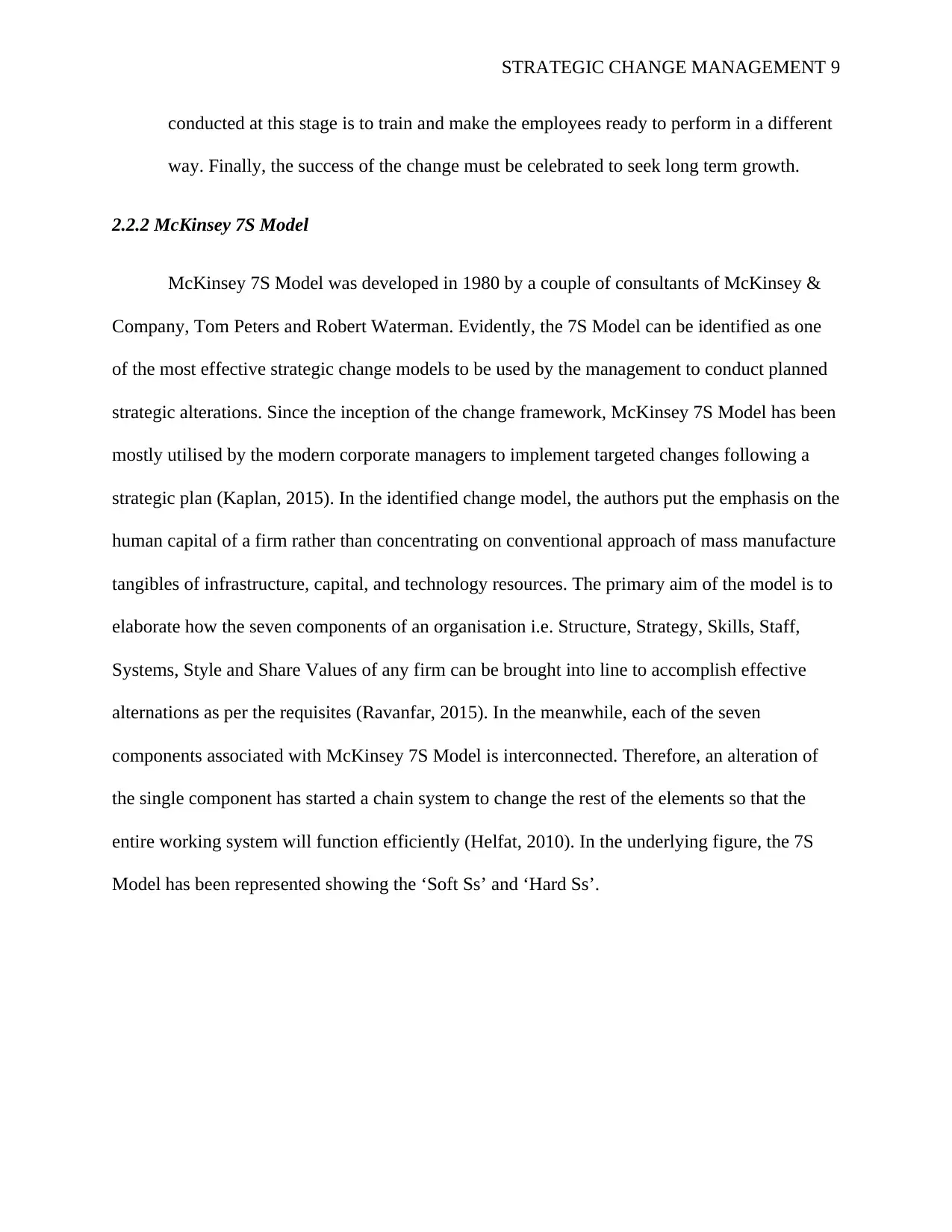
STRATEGIC CHANGE MANAGEMENT 9
conducted at this stage is to train and make the employees ready to perform in a different
way. Finally, the success of the change must be celebrated to seek long term growth.
2.2.2 McKinsey 7S Model
McKinsey 7S Model was developed in 1980 by a couple of consultants of McKinsey &
Company, Tom Peters and Robert Waterman. Evidently, the 7S Model can be identified as one
of the most effective strategic change models to be used by the management to conduct planned
strategic alterations. Since the inception of the change framework, McKinsey 7S Model has been
mostly utilised by the modern corporate managers to implement targeted changes following a
strategic plan (Kaplan, 2015). In the identified change model, the authors put the emphasis on the
human capital of a firm rather than concentrating on conventional approach of mass manufacture
tangibles of infrastructure, capital, and technology resources. The primary aim of the model is to
elaborate how the seven components of an organisation i.e. Structure, Strategy, Skills, Staff,
Systems, Style and Share Values of any firm can be brought into line to accomplish effective
alternations as per the requisites (Ravanfar, 2015). In the meanwhile, each of the seven
components associated with McKinsey 7S Model is interconnected. Therefore, an alteration of
the single component has started a chain system to change the rest of the elements so that the
entire working system will function efficiently (Helfat, 2010). In the underlying figure, the 7S
Model has been represented showing the ‘Soft Ss’ and ‘Hard Ss’.
conducted at this stage is to train and make the employees ready to perform in a different
way. Finally, the success of the change must be celebrated to seek long term growth.
2.2.2 McKinsey 7S Model
McKinsey 7S Model was developed in 1980 by a couple of consultants of McKinsey &
Company, Tom Peters and Robert Waterman. Evidently, the 7S Model can be identified as one
of the most effective strategic change models to be used by the management to conduct planned
strategic alterations. Since the inception of the change framework, McKinsey 7S Model has been
mostly utilised by the modern corporate managers to implement targeted changes following a
strategic plan (Kaplan, 2015). In the identified change model, the authors put the emphasis on the
human capital of a firm rather than concentrating on conventional approach of mass manufacture
tangibles of infrastructure, capital, and technology resources. The primary aim of the model is to
elaborate how the seven components of an organisation i.e. Structure, Strategy, Skills, Staff,
Systems, Style and Share Values of any firm can be brought into line to accomplish effective
alternations as per the requisites (Ravanfar, 2015). In the meanwhile, each of the seven
components associated with McKinsey 7S Model is interconnected. Therefore, an alteration of
the single component has started a chain system to change the rest of the elements so that the
entire working system will function efficiently (Helfat, 2010). In the underlying figure, the 7S
Model has been represented showing the ‘Soft Ss’ and ‘Hard Ss’.
⊘ This is a preview!⊘
Do you want full access?
Subscribe today to unlock all pages.

Trusted by 1+ million students worldwide
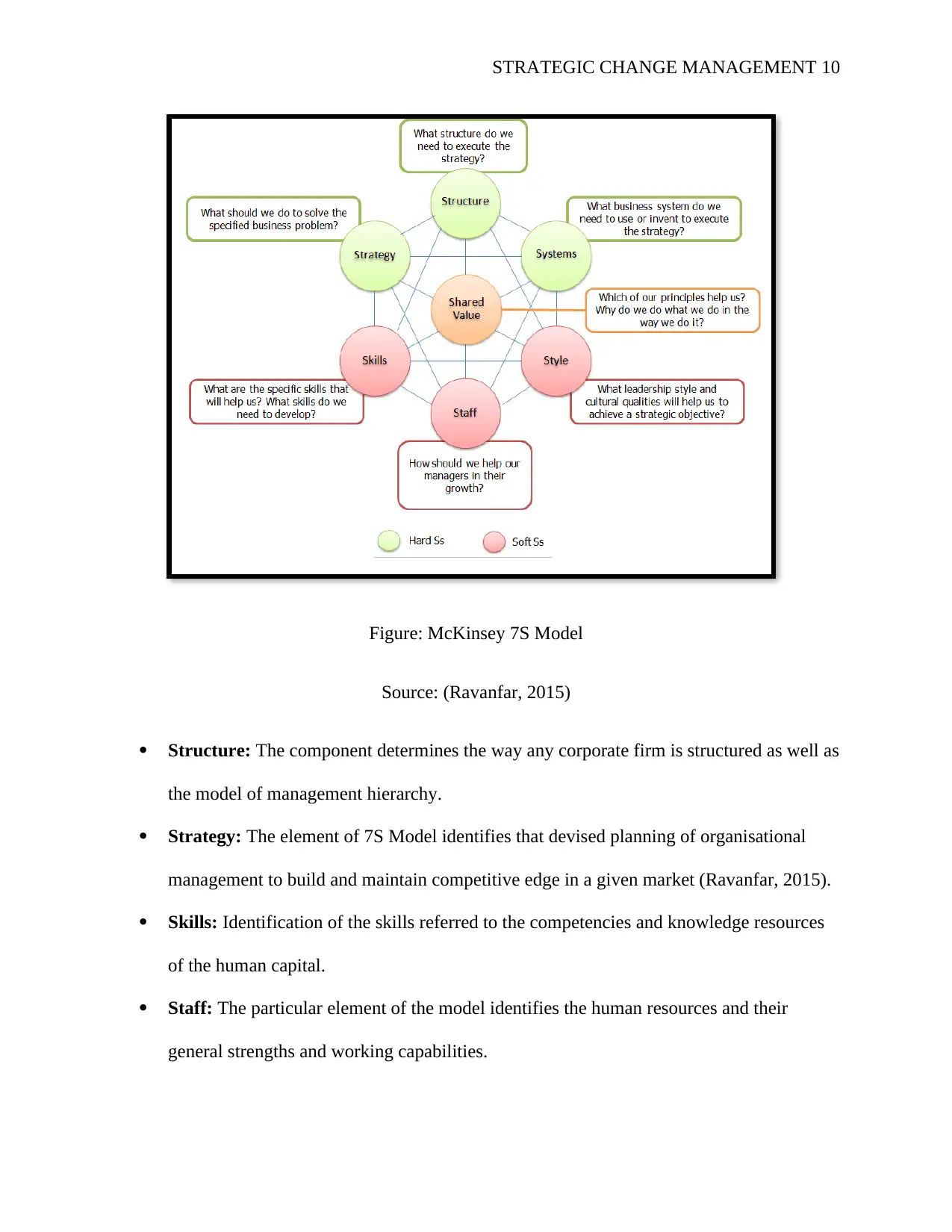
STRATEGIC CHANGE MANAGEMENT 10
Figure: McKinsey 7S Model
Source: (Ravanfar, 2015)
Structure: The component determines the way any corporate firm is structured as well as
the model of management hierarchy.
Strategy: The element of 7S Model identifies that devised planning of organisational
management to build and maintain competitive edge in a given market (Ravanfar, 2015).
Skills: Identification of the skills referred to the competencies and knowledge resources
of the human capital.
Staff: The particular element of the model identifies the human resources and their
general strengths and working capabilities.
Figure: McKinsey 7S Model
Source: (Ravanfar, 2015)
Structure: The component determines the way any corporate firm is structured as well as
the model of management hierarchy.
Strategy: The element of 7S Model identifies that devised planning of organisational
management to build and maintain competitive edge in a given market (Ravanfar, 2015).
Skills: Identification of the skills referred to the competencies and knowledge resources
of the human capital.
Staff: The particular element of the model identifies the human resources and their
general strengths and working capabilities.
Paraphrase This Document
Need a fresh take? Get an instant paraphrase of this document with our AI Paraphraser
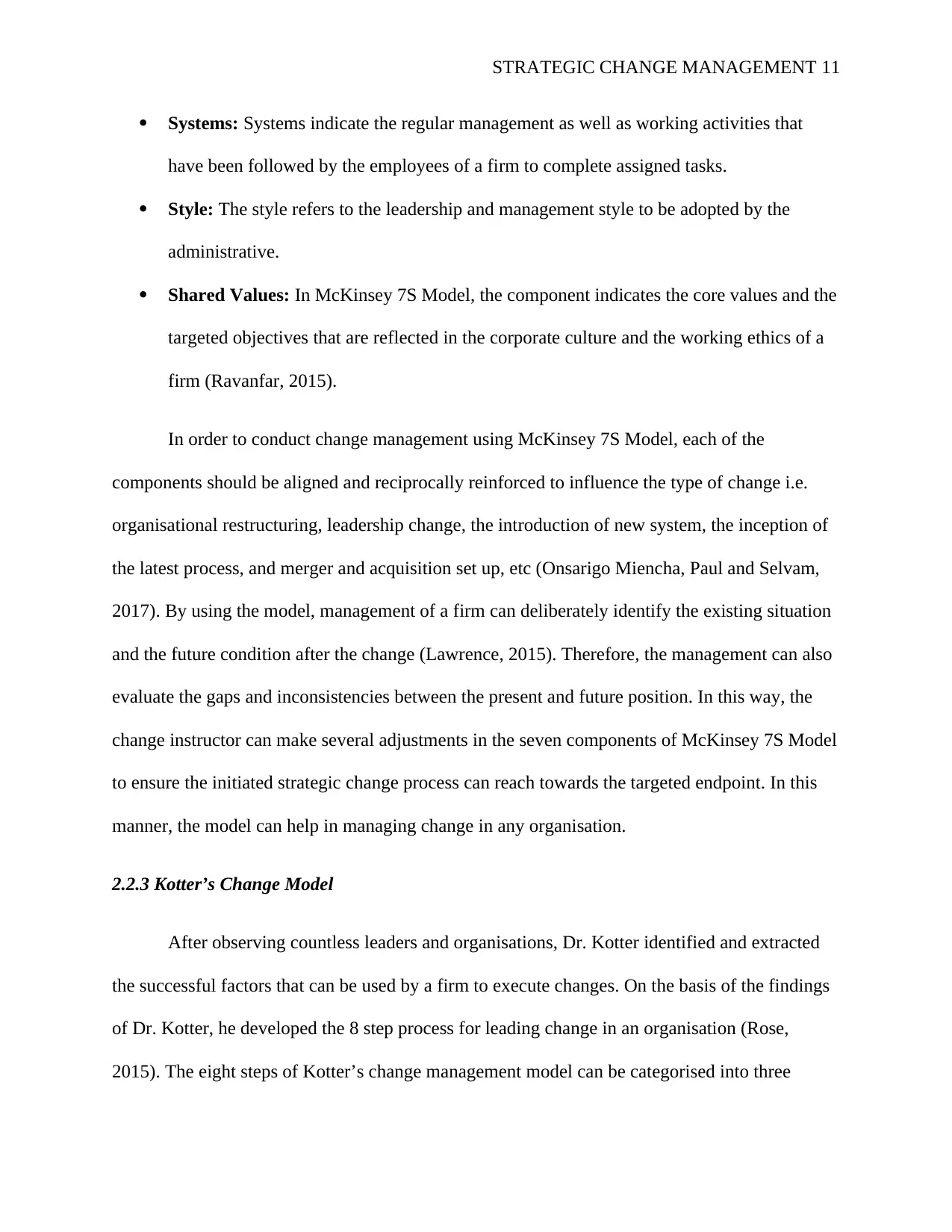
STRATEGIC CHANGE MANAGEMENT 11
Systems: Systems indicate the regular management as well as working activities that
have been followed by the employees of a firm to complete assigned tasks.
Style: The style refers to the leadership and management style to be adopted by the
administrative.
Shared Values: In McKinsey 7S Model, the component indicates the core values and the
targeted objectives that are reflected in the corporate culture and the working ethics of a
firm (Ravanfar, 2015).
In order to conduct change management using McKinsey 7S Model, each of the
components should be aligned and reciprocally reinforced to influence the type of change i.e.
organisational restructuring, leadership change, the introduction of new system, the inception of
the latest process, and merger and acquisition set up, etc (Onsarigo Miencha, Paul and Selvam,
2017). By using the model, management of a firm can deliberately identify the existing situation
and the future condition after the change (Lawrence, 2015). Therefore, the management can also
evaluate the gaps and inconsistencies between the present and future position. In this way, the
change instructor can make several adjustments in the seven components of McKinsey 7S Model
to ensure the initiated strategic change process can reach towards the targeted endpoint. In this
manner, the model can help in managing change in any organisation.
2.2.3 Kotter’s Change Model
After observing countless leaders and organisations, Dr. Kotter identified and extracted
the successful factors that can be used by a firm to execute changes. On the basis of the findings
of Dr. Kotter, he developed the 8 step process for leading change in an organisation (Rose,
2015). The eight steps of Kotter’s change management model can be categorised into three
Systems: Systems indicate the regular management as well as working activities that
have been followed by the employees of a firm to complete assigned tasks.
Style: The style refers to the leadership and management style to be adopted by the
administrative.
Shared Values: In McKinsey 7S Model, the component indicates the core values and the
targeted objectives that are reflected in the corporate culture and the working ethics of a
firm (Ravanfar, 2015).
In order to conduct change management using McKinsey 7S Model, each of the
components should be aligned and reciprocally reinforced to influence the type of change i.e.
organisational restructuring, leadership change, the introduction of new system, the inception of
the latest process, and merger and acquisition set up, etc (Onsarigo Miencha, Paul and Selvam,
2017). By using the model, management of a firm can deliberately identify the existing situation
and the future condition after the change (Lawrence, 2015). Therefore, the management can also
evaluate the gaps and inconsistencies between the present and future position. In this way, the
change instructor can make several adjustments in the seven components of McKinsey 7S Model
to ensure the initiated strategic change process can reach towards the targeted endpoint. In this
manner, the model can help in managing change in any organisation.
2.2.3 Kotter’s Change Model
After observing countless leaders and organisations, Dr. Kotter identified and extracted
the successful factors that can be used by a firm to execute changes. On the basis of the findings
of Dr. Kotter, he developed the 8 step process for leading change in an organisation (Rose,
2015). The eight steps of Kotter’s change management model can be categorised into three
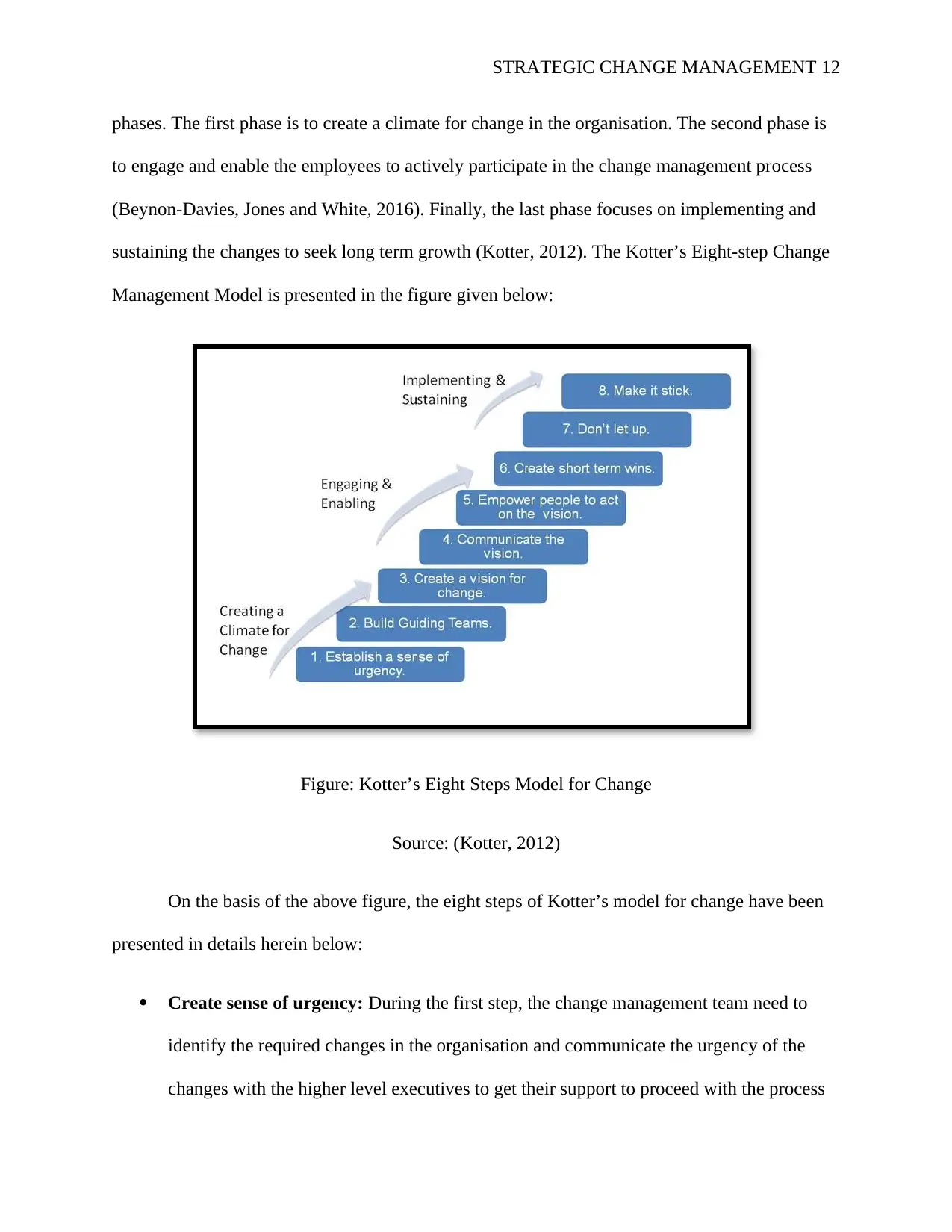
STRATEGIC CHANGE MANAGEMENT 12
phases. The first phase is to create a climate for change in the organisation. The second phase is
to engage and enable the employees to actively participate in the change management process
(Beynon-Davies, Jones and White, 2016). Finally, the last phase focuses on implementing and
sustaining the changes to seek long term growth (Kotter, 2012). The Kotter’s Eight-step Change
Management Model is presented in the figure given below:
Figure: Kotter’s Eight Steps Model for Change
Source: (Kotter, 2012)
On the basis of the above figure, the eight steps of Kotter’s model for change have been
presented in details herein below:
Create sense of urgency: During the first step, the change management team need to
identify the required changes in the organisation and communicate the urgency of the
changes with the higher level executives to get their support to proceed with the process
phases. The first phase is to create a climate for change in the organisation. The second phase is
to engage and enable the employees to actively participate in the change management process
(Beynon-Davies, Jones and White, 2016). Finally, the last phase focuses on implementing and
sustaining the changes to seek long term growth (Kotter, 2012). The Kotter’s Eight-step Change
Management Model is presented in the figure given below:
Figure: Kotter’s Eight Steps Model for Change
Source: (Kotter, 2012)
On the basis of the above figure, the eight steps of Kotter’s model for change have been
presented in details herein below:
Create sense of urgency: During the first step, the change management team need to
identify the required changes in the organisation and communicate the urgency of the
changes with the higher level executives to get their support to proceed with the process
⊘ This is a preview!⊘
Do you want full access?
Subscribe today to unlock all pages.

Trusted by 1+ million students worldwide
1 out of 50
Related Documents
Your All-in-One AI-Powered Toolkit for Academic Success.
+13062052269
info@desklib.com
Available 24*7 on WhatsApp / Email
![[object Object]](/_next/static/media/star-bottom.7253800d.svg)
Unlock your academic potential
Copyright © 2020–2025 A2Z Services. All Rights Reserved. Developed and managed by ZUCOL.





